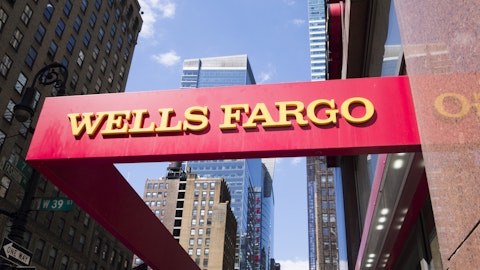Across all of our businesses, we’ve been very, very conservative in what we have asked people to do because we don’t want to have an asset cap issue. So again, I would describe it as, it’s the — it would be the ability to grow in the things that we’re confident at that we do well, that we have, in some ways, consciously and in some ways, unconsciously restrained the company from doing. But all in all, certainly, without an asset cap, it’s not a neutral. It’s a positive because of the things that we proactively stopped as well as we’re just limited in our ability to take advantage of the franchise that we have. And you’ve seen others that don’t have those constraints but have the quality franchise as well, and you see how they’ve benefited not just versus us but versus the broader banking set.
Steven Chubak: That’s really helpful context, Charlie. Thanks so much for taking my question.
Charlie Scharf: Of course.
Operator: The next question will come from John Pancari of Evercore ISI. Your line is open.
John Pancari: Good morning. On the 2024 NII guide, I understand that you feel better about the NII outlook here but you’re watching customer behavior. I know you did mention loan growth. Did you lower your loan growth outlook that’s baked into that guidance this quarter versus what you had in there last quarter? And either way, are you able to help us with what that expectation is on the loan growth front?
Mike Santomassimo: Yeah. John, it’s Mike. What we said in January is that we expected loans to decline in the first half, and so that’s about what we’re seeing, right? So again, it’s slightly lower than what we modeled, but it’s pretty close to sort of what our expectation. And then we expect a little bit of growth in the second half of the year and overall balances weren’t going to do much for the full year. And so at this point, could we be off on that a little bit? Maybe. And could it be a little lower? Maybe. Could it be a little higher? Yeah, for sure. And so — but I think the more meaningful drivers this year of where NII ends up, it’s going to come back to deposits, right? And what’s the level? What’s the mix? What’s the pricing look like, given where the environment is? And I think that will be the more meaningful place to focus.
John Pancari: Okay. And related to that, any deposit growth expectation that you could share?
Mike Santomassimo: Yeah. I mean, I think again, it’s — our full year guidance that we gave you or assumptions we gave you in January, where we thought the commercial side would be pretty flat to where we are, to where we started the year, that’s coming in slightly better than what we had modeled. In the consumer side, we would likely see a little bit of more decline as well as mix shift. And again, that’s what you’re seeing so far.
Charlie Scharf: Listen, we just — we want to be really careful in all this, right? We’re not — we’re trying to be as transparent as we can be about what we’re seeing without getting over our skis and making predictions that none of us have the answers to. And so like when you boil it all down in terms of the customer activity that we’re seeing, it’s a touch less here, a touch more there. There’s not a big change from what we said three months ago in terms of flows on the deposit and the lending side. It really is relatively small relative to the big NII picture and what’s going to drive NII at this point. So if we saw big changes there, we might say, let’s change guidance. But it’s tweaking along the way and we’ll see how it continues to pan out.
And then what we said is relative to the rate environment, it’s just — again, it’s — this is a full year number and we’ve had a couple of months go by. It’s just too early to mark the whole thing to market based upon that. But again, we also wanted to just provide the context, as Mike has said and I said in my remarks, certainly, what we’ve seen is helpful relative to just the pure overall rate and curve piece of it.
John Pancari: Okay, that’s very helpful. I appreciate the color there. If I could just ask one more along the credit side. NPA decline is encouraging there and I know it can be volatile. Can you just maybe talk about NPA inflows? Did you see a pullback there? Did you see that on the CRE side? Is there anything to [extract from] (ph) that? Thank you.
Mike Santomassimo: Yeah. No, look, I think what you’re seeing on the — when you talk about commercial real estate, you’re really talking about office. And what you saw in the office space is actually, it did not move at all and get worse or not get worse in the quarter. And so you actually saw non-performing assets coming down a little bit in the CRE space as we’ve charged off some loans, and they weren’t replaced by other items. And so that’s a positive in the sense that it’s not deteriorating at this point. And then everything else is sort of moving around like as you would expect. There’s not substantial movements across the rest of the portfolio.
John Pancari: Great. Thanks, Mike.
Operator: The next question comes from Matt O’Connor of Deutsche Bank. Your line is open.
Matt O’Connor: Hi, good morning. I want to follow up on the comment that costs this year could come in higher on higher revenues, investment advisory, and I would assume the same if banking and trading continue to be so strong. Obviously, that’s a net positive to earnings overall. But how would you frame the operating leverage if you can pick which revenue buckets, but if those market-sensitive revenues are $1 billion higher, is there kind of 40% cost [against that] (ph), 50%? How would you frame that? Thank you.
Mike Santomassimo: Yeah. And really what we’re referring to when we mention that is primarily in the wealth management business is where we’re focused, given where market levels are. And that business is — the cost-to-income ratio is pretty stable there in terms of the revenue-related comp. And so it’s a little less than 50% in terms of how to think about it. So the operating leverage is good.
Matt O’Connor: Okay, that’s helpful. And then just specifically on banking and trading, I know you guys invested in those businesses so there’s upfront costs when the revenues come. But it seems like the operating leverage in that segment has been very, very strong. And is that something that you think can continue if those revenues continue to surprise or could we see some upward pressure to cost from that, again, a positive to earnings overall but — thanks.
Mike Santomassimo: Yeah. No, look, I think the cost to invest there, as Charlie noted, is in our numbers, right, so that’s already there. So we’re already anticipating that. And at this point, we don’t see that being a big pressure point one way or the other. But obviously, as you know, if revenues like far exceed our expectations in a positive way, that would come with a little bit of comp, too. So that would be a good thing overall.
Matt O’Connor: Yeah, agreed. Okay, thank you.
Operator: The next question will come from Gerard Cassidy of RBC Capital Markets. Your line is open.
Gerard Cassidy: Thank you. Hi, Mike and Charlie. Mike, you touched on your non-interest-bearing deposits declined to about 26% of deposits. Do you guys have a sense what’s the long-term normalization level for non-interest-bearing deposits as you look out over the 12-month horizon? Assuming rates do not go up, we have stable rates, maybe they come down a little bit?
Mike Santomassimo: Yeah. Look, I mean, it’s a hard thing to say with a whole lot of certainty, Gerard, in terms of exactly where it’s going to stabilize. It will stabilize at some point, particularly as you look at the underlying mix of the consumer deposit base, right? A good chunk of our consumer deposits are in accounts less than [2.50] (ph). They are generally operating accounts for a lot of people, and so this thing will stabilize as we go. But as you’ve seen, we’ve had some pretty consistent, plus or minus a little bit, each quarter as we’ve gone through the last number of quarters. But at some point soon, that will start to — we would expect that to stabilize, but we’ll see exactly where it does.
Gerard Cassidy: And is it fair to assume that the rate of change in the deposit betas is declining, where eventually those deposit betas flatten out as well?
Mike Santomassimo: Yeah. Once you start seeing more stabilization in the mix, that’s when you’ll see deposit costs on the consumer side stabilize, right? Because what you’re seeing now is people — as I mentioned earlier, people are spending money in their checking account, low interest cost for us. And then you’re seeing growth in CDs and some of the savings accounts, which are higher cost. And that mix shift will stabilize. It’s very related to your first question around non-interest-bearing, right? Once — they’re kind of related together, right? Once you get to sort of that core operating balance in people’s accounts, then that’s when you’ll see both of those stabilize.
Gerard Cassidy: Great. And then just as a follow-up on credit, obviously, you guys put up overall good numbers and especially in that commercial real estate area, as you highlighted. Coming back to the credit cards, you pointed out that the charge-offs were up, but they’re in line with the expectations. Assuming the economy does not head into a recession later this year and unemployment goes up to 6%, say it stays around 4%, what are you guys thinking for like a peak in net charge-offs or credit cards? And when do you think you could reach that?





